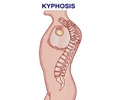Astronauts on long missions in space experience moderate to severe backache due to atrophy or shrinkage of the muscles supporting the spine.
Highlights
- Astronauts on long space mission experience severe backache and spinal disc conditions.
- This can be attributed to atrophy of paraspinal muscles supporting the spine.
- Astronauts also have a higher risk of developing spinal disc herniation.
- Not bending over or using the lower back muscles is the reason for muscle atrophy, pain and stiffness.
"This could provide helpful physiological information to support a manned mission to Mars," the researchers write.
The inter-vertebral discs create a cushion between vertebrae in a person’s spine. Any change to its shape and size can affect the spinal column and back.
Astronauts have been reporting back pain since 1980’s during prolonged mission, especially lower back pain. Around 28% indicated that they experience moderate to severe pain.
Aim of the Study
The goal was to understand factors that affect lumbar spine strength and the source of low back pain during long-duration spaceflight, as well as the how the spine responds after returning to Earth gravity.
Methods and Findings of the Study
Six NASA crew members were studied before and after spending four to seven months in "microgravity" conditions on the International Space Station.
Each astronaut underwent magnetic resonance imaging (MRI) scans of the spine before their mission, immediately after their return to Earth, and again one to two months later.
It was noticed that astronauts are at increased risk of spinal disc herniation in the months after returning from spaceflight, about four times higher than in matched controls. In the first year after return from space, astronauts have 4.3 times higher risk of herniated disc
Though these changes cause an increase in height by two inches, it is accompanied by weakening of muscles supporting the spine.
The change in height is due to spinal "unloading" in which the spinal curve flattens and other changes related to the lack of gravity.
Astronauts do not use their lower back muscles much as they do not bend over. This is the reason for pain and stiffening.
To estimate lean muscle separated from non-lean muscle components, researchers used an image thresh-holding technique.
Lean muscles play a critical role in spinal support and movement. The MRI scans indicated significant atrophy of the paraspinal lean muscle mass during the astronauts' time in space.
The lean muscle, or "functional," cross-sectional area of the lumbar paraspinal muscles decreased by an average of 19% from pre-flight scans to immediate post-flight scans.
The ratio of lean muscle decreased from 86% pre-flight to 72% immediately.
A month or two later, only about two-thirds of the reduction had recovered at 81% but was still less than the preflight value.
"Even after six weeks of training and reconditioning here on Earth, they are only getting about 68% of their losses restored," Chang explained.
In contrast, there was no consistent change in the height of the spinal intervertebral discs. Dr. Chang and coauthors write, "These measurements run counter to previous hypotheses about the effects of microgravity on disc swelling."
Preventive Measures
The results give insight into back pain and inter-vertebral disc risks, suggesting possible countermeasures targeted to the lumbar paraspinal muscles while in-flight and during the preflight and after fight periods
The data reveal lumbar spine paraspinal muscle atrophy after long-duration spaceflight.
Though some functional cross-sectional area recovery was seen 46 days after space flight in a terrestrial environment, it remained incomplete compared to pre-light levels.
Further studies will be needed to clarify the effects on disc height, and whether they contribute to the increase in body height during space missions, and to the increased risk of herniated disc disease.
According to the study authors, "Whether new exercise countermeasures can prevent in-flight paraspinal muscle atrophy, improve spinal pain and function, shorten recovery time, and how such exercise might be performed in a microgravity environment with available exercise equipment need further study."
Reference
- NASA study shows that space travel affects spine of astronauts - (https://www.eurekalert.org/pub_releases/2016-10/wkh-nss102516.php)













